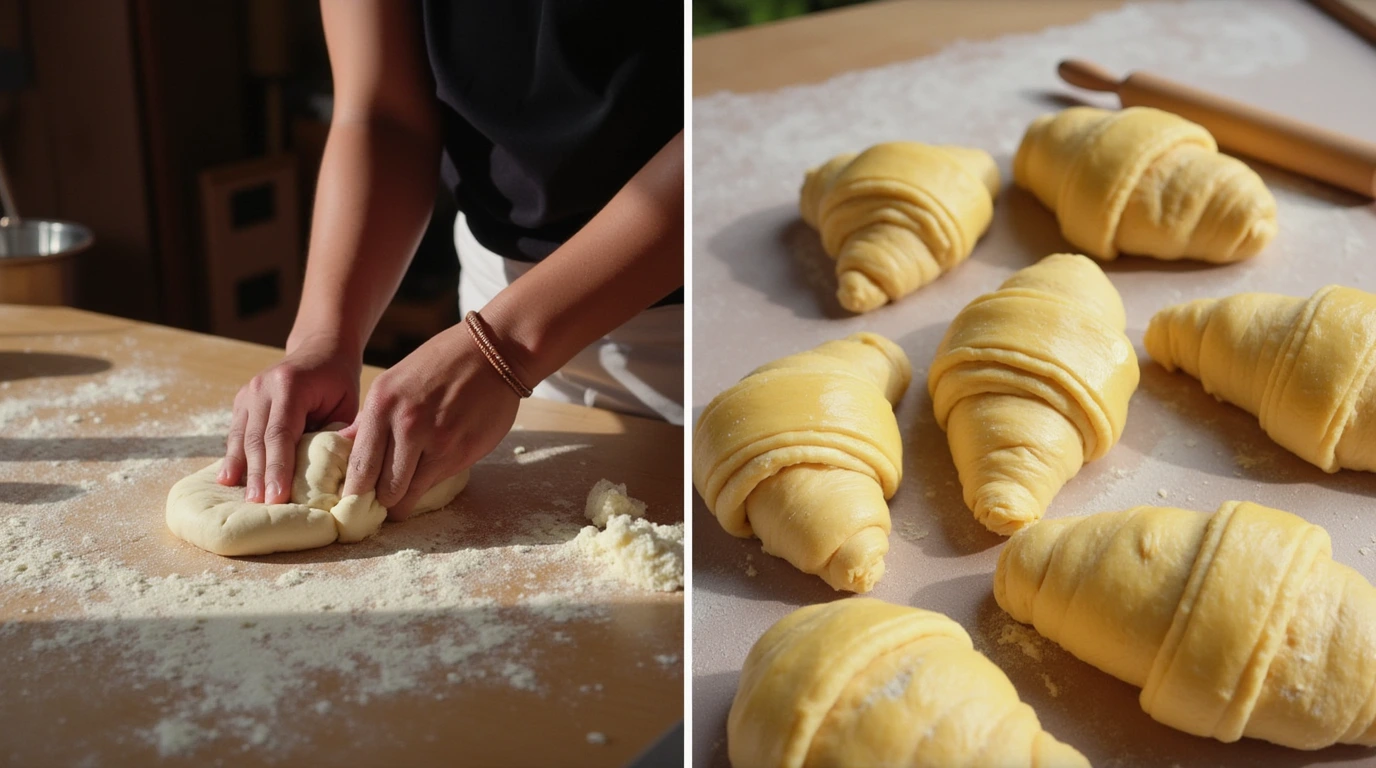Croissants are the epitome of indulgence—light, buttery, and flaky. However, making a gluten free croissant that matches the texture and flavor of its traditional counterpart can seem like an impossible feat. Whether you’re following a gluten free diet due to celiac disease, gluten intolerance, or personal choice, this guide will provide detailed instructions, tips, and pairing ideas to help you perfect the art of making these iconic pastries.
Why Choose Gluten Free Croissants?
For many, a gluten free diet isn’t just a preference—it’s a lifestyle. Gluten, a protein found in wheat, barley, and rye, can trigger severe health issues for those with gluten sensitivities or celiac disease. Yet, giving up gluten doesn’t mean giving up on delicious baked goods.
Gluten free croissants allow you to enjoy a luxurious pastry experience without compromising your dietary needs. They pair perfectly with hearty sides like Gluten Free Cornbread, which complements the buttery layers with a wholesome, slightly sweet flavor.
The Science of Gluten Free Baking
Baking without gluten involves rethinking traditional techniques to recreate the structure and texture that gluten provides. Croissants, known for their flaky layers and airy interiors, rely heavily on gluten’s unique properties. In gluten free baking, achieving these characteristics requires carefully chosen substitutes and precise methods.
Key Components of Gluten Free Croissant Dough:
1. Flour Blend
A well-balanced mix of alternative flours is essential to replicate the performance of wheat flour:
- Almond Flour: Adds richness and a slightly nutty flavor.
- Tapioca Starch: Contributes elasticity and a chewy texture.
- Sorghum Flour: Provides structure and enhances the dough’s flavor.
These flours work in harmony to create a dough that is pliable yet strong enough to withstand lamination.
2. Binders
Without gluten, the dough lacks the “glue” needed to hold it together. Binders such as:
- Xanthan Gum: A common choice for adding elasticity and strength.
- Psyllium Husk: Provides similar benefits while also enhancing moisture retention.
These binders prevent the dough from crumbling during the rolling and shaping processes, ensuring the finished croissant has well-defined layers.
3. Butter
High-quality, cold butter is the star ingredient for creating the flaky layers that croissants are famous for. The lamination process relies on:
- Firm Butter Layers: Prevents the dough from merging completely, maintaining separation for flakiness.
- Consistent Chilling: Keeps the butter solid during folding and rolling, ensuring distinct layers are formed.
4. Leavening Agent
Traditional croissants depend on yeast to create their signature airy texture. In gluten free baking, yeast performs the same function by:
- Creating air pockets within the dough for lightness.
- Adding depth of flavor through fermentation.
Active dry yeast or instant yeast works well for this purpose, as long as the dough is given enough time to proof and rise.
Understanding Dough Behavior in Gluten Free Baking
Unlike wheat-based dough, gluten free doughs can be:
- Stickier: Due to the absence of gluten, they are less cohesive and require frequent flouring of surfaces.
- Fragile: Overhandling the dough can break down its structure, so gentle techniques are essential.
- Moisture-Sensitive: Maintaining the right hydration level is critical for pliability and preventing dryness.
Tools and Techniques for Success
- Rolling Pin and Pastry Mat: Essential for achieving even lamination without overworking the dough.
- Bench Scraper: Helps handle sticky dough and ensures clean edges during shaping.
- Chill Periods: Rest the dough in the refrigerator between folds to keep it manageable and prevent butter from melting.
Pairing Ideas for Gluten Free Croissants
To create a complete gluten free breakfast experience, consider serving your croissants with Gluten Free Banana Pancakes. These fluffy, flavorful pancakes provide a satisfying contrast to the croissants’ crisp, flaky texture and are an excellent choice for a family-friendly brunch.
By understanding the science behind gluten free baking and applying these techniques, you can create croissants that are just as indulgent and delicious as their traditional counterparts.
Ingredients for Perfect Gluten Free Croissants
Here’s what you’ll need to create buttery, flaky croissants:
- Flour Blend:
- 2 cups almond flour
- 1 cup tapioca starch
- 1/2 cup sorghum flour
- Binders and Enhancers:
- 1 tsp xanthan gum or psyllium husk
- 1/2 tsp salt
- 1 tbsp sugar (optional, for slightly sweeter croissants)
- Wet Ingredients:
- 1 packet of active dry yeast
- 1/2 cup warm milk (or non-dairy alternative)
- 1/2 cup cold butter (or non-dairy substitute)
Techniques for Achieving Flakiness Without Gluten

1. The Importance of Cold Ingredients
Cold butter and dough are essential for creating layers. If the butter starts to melt during the lamination process, it can ruin the structure of the croissants. Chill your dough and butter between each step.
2. Lamination Process
Lamination involves rolling out the dough, placing thin sheets of cold butter over it, folding the dough, and repeating this process multiple times. This creates the signature layers found in croissants.
3. Resting and Proofing
Allow the dough to rest in the refrigerator between folds. After shaping the croissants, proof them at room temperature for 2–3 hours to ensure they rise properly.
If you’re struggling with dough texture or rising issues, explore troubleshooting tips at Gluten Free Breakfast Bake Without Hash Browns.
Step-by-Step Recipe: Gluten Free Croissants
Preparation:
- Activate the Yeast: Combine warm milk and sugar, then stir in the yeast. Let it sit for 5–10 minutes until frothy.
- Mix the Dry Ingredients: In a large bowl, mix almond flour, tapioca starch, sorghum flour, xanthan gum, and salt.
- Combine Wet and Dry: Gradually add the yeast mixture to the dry ingredients, mixing until a sticky dough forms.
Lamination:
- Roll out the dough into a rectangular shape.
- Place thin slices of cold butter evenly over the dough.
- Fold the dough like a letter (one-third over the center, then the other third on top).
- Rotate the dough 90°, roll it out again, and repeat the folding process 3–4 times, chilling the dough for 20 minutes between folds.
Shaping and Baking:
- Roll out the dough and cut it into triangles. Roll each triangle from the base to the tip to form the croissant shape.
- Proof the croissants at room temperature for 2–3 hours until they double in size.
- Bake in a preheated oven at 375°F for 20–25 minutes or until golden brown.
Pairing Ideas and Variations
One of the best aspects of croissants, especially gluten free croissants, is their versatility. They can be enjoyed plain, as a base for creative fillings, or paired with complementary dishes to create a complete meal. Here are some delicious ways to customize your croissants and elevate your breakfast or brunch experience.
Sweet Variations
Sweet fillings and toppings bring out the buttery richness of croissants, making them perfect for indulgent breakfasts or desserts. Try these options:
- Chocolate-Filled: Add a square of dark or milk chocolate to the dough before rolling it into its classic crescent shape. The chocolate melts during baking, creating a gooey, rich center.
- Almond Paste or Marzipan: Spread almond paste on the dough before rolling, or fill the baked croissants with marzipan for a nutty, sweet twist.
- Fruit Preserves or Compote: Serve warm croissants with a side of fruit preserves like raspberry, apricot, or blueberry. You can also bake the croissants with a dollop of compote inside for a fruity surprise.
- Glazed Croissants: Drizzle a simple sugar glaze or honey over the croissants after baking for added sweetness and shine.
Savory Variations
Savory croissants are a fantastic option for brunch or as a snack. Their versatility allows you to add a range of flavorful fillings:
- Spinach and Feta: Add a mixture of sautéed spinach and crumbled feta cheese to the dough before rolling. This combination is both tangy and creamy.
- Cheese and Herbs: Sprinkle shredded cheddar, Gruyère, or mozzarella with chopped fresh herbs like rosemary or thyme for a cheesy, fragrant option.
- Sun-Dried Tomatoes and Basil: Spread sun-dried tomato paste or place small pieces of sun-dried tomatoes with fresh basil leaves for a Mediterranean-inspired treat.
- Ham and Cheese (Using Alternatives): Use turkey ham or beef bacon with Swiss cheese for a classic savory croissant that’s free of pork.
Pairing Ideas for Breakfast or Brunch
Croissants shine brightest when paired with other complementary dishes. Here are some ideas to build a memorable breakfast spread:
- Gluten Free Banana Pancakes: These fluffy pancakes provide a soft, sweet contrast to the flaky croissants.
- Egg Dishes: Serve your croissants alongside scrambled eggs, a vegetable frittata, or an omelet for a protein-packed meal.
- Fresh Fruit Salad: A light and refreshing mix of seasonal fruits like berries, melons, and citrus balances the richness of croissants.
- Coffee or Tea: A strong cup of coffee or herbal tea complements the buttery layers of croissants perfectly.
Dessert Croissant Ideas
Transform your croissants into a decadent dessert with these ideas:
- Croissant Bread Pudding: Cube leftover croissants and bake them with custard, cinnamon, and raisins for a comforting dessert.
- Ice Cream Sandwiches: Slice croissants in half and fill them with your favorite ice cream flavor for a unique treat.
- Drizzled Chocolate and Nuts: Top baked croissants with melted chocolate and a sprinkle of chopped hazelnuts or almonds.
Tips for Serving Croissants
- Warm croissants in the oven for 5 minutes at 350°F to enhance their texture and aroma before serving.
- Pair croissants with both sweet and savory spreads, such as honey, cream cheese, or pesto, to cater to all preferences.
- Offer a variety of sweet and savory fillings on a platter, letting guests customize their own croissants.
With these pairing ideas and variations, your gluten free croissants can easily become the star of any meal. Whether you’re serving them for breakfast, brunch, or dessert, these versatile pastries are sure to impress and delight everyone at the table.
Frequently Asked Questions
Why is gluten free baking more challenging?
Without gluten, which acts as a natural binder in traditional baking, gluten free doughs lack elasticity and structure. This makes them more prone to crumbling or being dense. To counter this, bakers rely on substitutes like xanthan gum or psyllium husk, which help mimic gluten’s properties and provide the necessary elasticity and strength.
How long do gluten free croissants last?
Gluten free croissants are best enjoyed fresh due to the delicate nature of their texture. However:
- At Room Temperature: Store in an airtight container for up to 2 days.
- In the Freezer: Freeze the croissants for up to 3 months. To reheat, place them in a preheated oven at 350°F for about 5–7 minutes, restoring their flakiness and warmth.
Can I make vegan gluten free croissants?
Absolutely! Making vegan gluten free croissants is a great option for those with additional dietary restrictions. Here’s how:
- Butter Substitute: Use a high-quality plant-based butter that remains solid when cold for proper lamination.
- Milk Substitute: Almond milk, oat milk, or soy milk works well as a replacement for dairy milk.
- Additional Tip: Ensure your plant-based butter is unsalted, or adjust the recipe accordingly to maintain the croissant’s flavor balance.
Why is my gluten free croissant dough so sticky?
Gluten free doughs are often stickier than traditional doughs due to the absence of gluten. To manage this:
- Chill the dough frequently to make it easier to work with.
- Dust your rolling surface generously with gluten free flour, such as tapioca starch or rice flour.
- Work quickly and avoid overhandling the dough to prevent it from warming up too much.
Can I use a stand mixer for gluten free croissant dough?
Yes! A stand mixer can save time and effort when combining ingredients. Use the dough hook attachment to knead the dough for a few minutes until it reaches a smooth, pliable consistency. Avoid overmixing, as gluten free doughs can become overly dense if worked too much.
Do gluten free croissants taste different?
While gluten free croissants may have a slightly different texture compared to traditional ones, they can be just as delicious. Using high-quality ingredients like almond flour, butter, and binders ensures a buttery, flaky, and flavorful result. The key is balancing the ingredients to achieve the right texture without the use of gluten.
How can I make my gluten free croissants flakier?
To enhance flakiness:
- Chill Butter Properly: Ensure the butter is cold and firm throughout the lamination process.
- Multiple Folds: Complete at least 3–4 folds during lamination to create enough layers.
- Rest Between Steps: Allow the dough to chill between each fold to keep the butter from melting.
With these tips, your gluten free croissants will have beautiful, defined layers and a flaky texture.
Final Thoughts
Making gluten free croissants is a rewarding experience that combines precision and creativity. With the right techniques, ingredients, and a little patience, you can enjoy these iconic pastries without compromising on taste or texture. Don’t forget to explore complementary recipes like Gluten Free Cornbread or Gluten Free Breakfast Bake Without Hash Browns for a complete gluten free breakfast experience. Happy baking!

